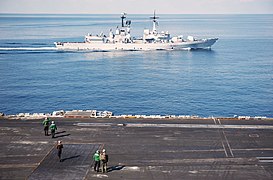
A carrier battle group (CVBG) is a naval fleet consisting of an aircraft carrier capital ship and its large number of escorts, together defining the group. The CV in CVBG is the United States Navy hull classification code for an aircraft carrier.

In naval terminology, a destroyer is a fast, maneuverable, long-endurance warship intended to escort larger vessels in a fleet, convoy, or carrier battle group and defend them against a wide range of general threats. They were originally conceived in 1885 by Fernando Villaamil for the Spanish Navy as a defense against torpedo boats, and by the time of the Russo-Japanese War in 1904, these "torpedo boat destroyers" (TBDs) were "large, swift, and powerfully armed torpedo boats designed to destroy other torpedo boats". Although the term "destroyer" had been used interchangeably with "TBD" and "torpedo boat destroyer" by navies since 1892, the term "torpedo boat destroyer" had been generally shortened to simply "destroyer" by nearly all navies by the First World War.

The Nimitz class is a class of ten nuclear-powered aircraft carriers in service with the United States Navy. The lead ship of the class is named after World War II United States Pacific Fleet commander Fleet Admiral Chester W. Nimitz, who was the last living U.S. Navy officer to hold the rank. With an overall length of 1,092 ft (333 m) and a full-load displacement of over 100,000 long tons (100,000 t), the Nimitz-class ships were the largest warships built and in service until USS Gerald R. Ford entered the fleet in 2017.

USS Dwight D. Eisenhower (CVN-69) is a nuclear-powered aircraft carrier currently in service with the United States Navy. Commissioned in 1977, the ship is the second of ten Nimitz-class aircraft carriers currently in service, and is the first ship named after the 34th President of the United States and General of the Army, Dwight D. Eisenhower. The vessel was initially named simply as USS Eisenhower, much like the lead ship of the class, Nimitz, but the name was changed to its present form on 25 May 1970. The carrier, like all others of her class, was constructed at Newport News Shipbuilding Company in Virginia, with the same design as the lead ship, although the ship has been overhauled twice to bring her up to the standards of those constructed more recently.
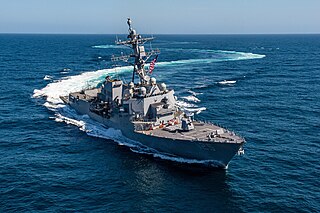
The Arleigh Burke class of guided-missile destroyers (DDGs) is a United States Navy class of destroyer centered around the Aegis Combat System and the SPY-1D multi-function passive electronically scanned array radar. The class is named after Admiral Arleigh Burke, an American destroyer officer in World War II and later Chief of Naval Operations. With an overall length of 505 to 509.5 feet, displacement ranging from 8,300 to 9,700 tons, and weaponry including over 90 missiles, the Arleigh Burke-class destroyers are larger and more heavily armed than many previous classes of guided-missile cruisers.

A guided-missile destroyer (DDG) is a destroyer whose primary armament is guided missiles so they can provide anti-aircraft warfare screening for the fleet. The NATO standard designation for these vessels is DDG, while destroyers which have a primary gun armament or a small number of anti-aircraft missiles sufficient only for point-defense are designated DD. Nations vary in their use of destroyer D designation in their hull pennant numbering, either prefixing or dropping it altogether.

USS Gyatt (DD-712/DDG-1/DDG-712) was a Gearing-class destroyer of the United States Navy operated between 1945 and 1968. The ship was named for Edward Earl Gyatt, a United States Marine Corps private and Marine Raider killed during the Battle of Guadalcanal. She was laid down in 1944, commissioned in 1945, and missed combat during the Second World War. In 1955, she was converted into the world's first guided missile destroyer (DDG) to evaluate the RIM-2 Terrier surface-to-air missile and the practicality of similar weapons.

USS Belknap (DLG-26/CG-26), named for Rear Admirals George E. Belknap (1832–1903) and his son Reginald Rowan Belknap (1871–1959), was the lead ship of her class of guided missile cruisers in the United States Navy. She was launched in 1963 as DLG-26, a guided missile frigate under the then-current designation system, and reclassified as CG-26 on 30 June 1975.

The Spruance-class destroyer was developed by the United States to replace the many World War II–built Allen M. Sumner- and Gearing-class destroyers, and was the primary destroyer built for the United States Navy during the 1970s and 1980s. It was named in honor of U.S. Navy Admiral Raymond A. Spruance, who successfully led major naval battles in the Asiatic-Pacific Theater during World War II such as the Battle of Midway and the Battle of the Philippine Sea.

USS Oklahoma City (CL-91/CLG-5/CG-5) was one of 27 United States Navy Cleveland-class light cruisers completed during or shortly after World War II, and one of six to be converted to guided missile cruisers. She was the first US Navy ship to be named for Oklahoma City, Oklahoma. Commissioned in late 1944, she participated in the latter part of the Pacific War in anti-aircraft screening and shore bombardment roles, for which she earned two battle stars. She then served a brief stint with the occupation force. Like all but one of her sister ships, she was retired in the post-war defense cutbacks, becoming part of the Pacific Reserve Fleet in 1947.
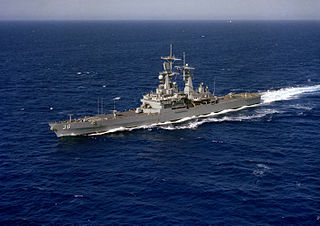
The Virginia class were four nuclear-powered, guided-missile cruisers that served in the United States Navy until the mid-to-late 1990s. The double-ended cruisers were commissioned between 1976 and 1980. They were the final class of nuclear-powered cruisers completed and the last ships ordered as Destroyer Leaders under the pre-1975 classification system.

Marquis Luigi Durand de la Penne was an Italian Navy admiral who served as naval diver in the Decima MAS during World War II. He was born in Genoa, where he also died.

The Audace-class destroyers were two guided missile destroyers built for the Italian Navy during the Cold War. An improvement of the Impavido class, these ships were designed for area air defence and also had a heavy gun armament. They were fitted with contemporary American radars and sonars, but also, as the next Italian ships, all the modern weapons made by Italian industry of the time, such as torpedoes, helicopters and guns. Also some indigenous radars were fitted.
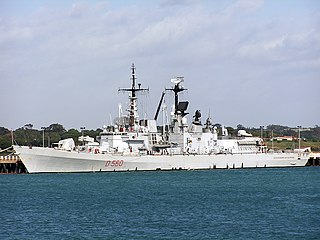
The Durand de la Penne class are two guided-missile destroyers operated by the Italian Navy. The design is an enlarged version of the Audace class, updated with diesel and gas turbine CODOG machinery and modern sensors. Four ships were planned but the second pair were cancelled when Italy joined the Horizon project.
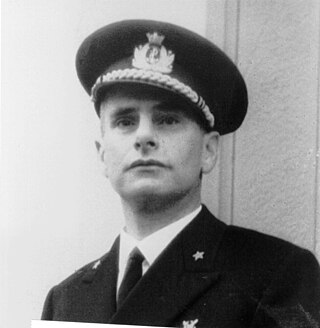
Francesco Mimbelli was an Italian naval officer who fought in World War II.

Caio Duilio is a destroyer of the Italian Navy. She and her sister Italian destroyer Andrea Doria form the Andrea Doria class; in turn these two ships, and the French vessels Forbin and Chevalier Paul, belong to the Horizon class. Caio Duilio is marked by hull number D 554 according to NATO classification.

Andrea Doria is a destroyer of the Italian Navy. She and her sister Caio Duilio form the Andrea Doria class; in turn these two ships, and the French vessels Forbin and Chevalier Paul, belong to the Horizon class. Andrea Doria has the hull number D 553 according to NATO classification.
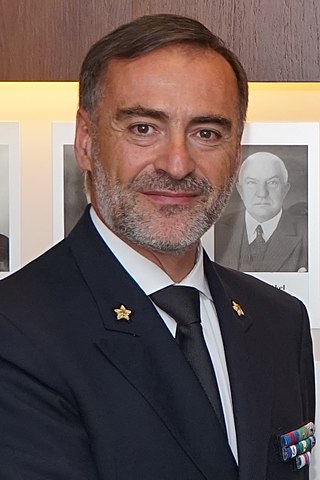
Enrico Credendino is an officer of the Italian Navy. He was appointed Chief of the Italian Navy in November 2021.
Ardimentoso has been borne by at least three ships of the Italian Navy and may refer to:

Luigi Durand de la Penne(D 560) is the lead ship of the Durand de la Penne-class destroyer of the Italian Navy.



